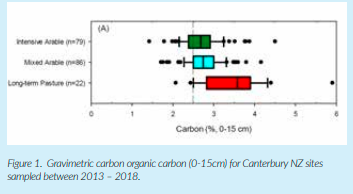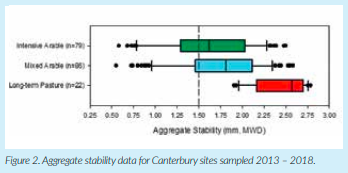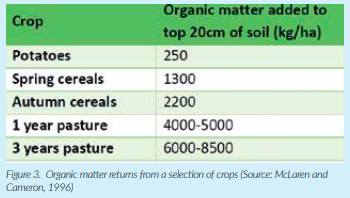AHDB Knowledge Exchange Manager, Teresa Meadows paid a visit to the New Zealand Foundation of Arable
Research to understand how they are tackling key agricultural challenges faced by UK farmers.

Soil health, improving soil structure, wider environmental concerns and high-quality yields are certainly at the front of New Zealand arable farmers minds, as they are ours. Following a visit from Abie Horrocks, Research Manager at FAR, to our AHDB HQ in Stoneleigh last autumn as part of a visit to the UK that she was doing to talk about soils, I thought I would pay a return visit. My sister lives in New Zealand and is farming with her husband and family and so while I was visiting them earlier this year, I took the opportunity to spend a couple of days with FAR, to learn more about their work and research. The Foundation of Arable Research (FAR) is the arable levy board in New Zealand and has a similar role to AHDB Cereals and Oilseeds, with a focus on research to:
• Enable a sustainable and profitable cropping industry by investing in research, development and extension to foster positive change.
• To make cropping the highest returning sustainable land use for New Zealand farmers.
(FAR Objectives, FAR Profile)
This research work has a wide remit, including wheat cultivar performance, spring N response in oilseed rape, control of sow thistle in white clover seed crops and post-harvest weed seed management to name a few. However, alongside this, a significant investment has been made into research on the management of soils, as here in the UK.
The arable area in New Zealand is predominantly concentrated in the fertile Canterbury area in the South Island, near Christchurch, where, when I asked a grower if they employed precision farming and variable rate technology, the answer came back: “there’s no return from it, because our soils and fields are so uniform”! However, with the majority irrigating their crops, practice a wide rotation that typically includes herbage grass seed and vegetable seed and livestock grazing over the winter, the need to minimise compaction and boost soil health is still evident. Many quoted limited amounts of topsoil, with a gravel layer underneath and indeed, most soil sampling was only done down to 30cm.


Whilst with FAR, Abie talked through a recently completed large soil benchmarking project, which has been reported to their growers and was presented in their ‘Grower Round-Up’ meetings that I attended. There are results that I think would be of interest to you all from this piece of work. The project looked at intensive arable cropping (continuous arable cropping for >6 years) and mixed arable sites (annual cropping with a phase of grass pasture or grass/clover seed crop maintained for 18 months or greater) over 327 paddocks (!) with a focus on soil physical quality. These fields were looked at for key indicators, primarily:
• Carbon (% and t/ha): an index of organic matter content (on average OM = 58% C)
• Aggregate stability: a measure of soil resilience
The results from the Canterbury sites showed that 62% of the intensive arable sites, 76% of the mixed arable and 91% of the long-term sheep pasture sites met the national recommended target of 2.5% carbon (0-15cm), see Figure 1. When comparing this to the aggregate stability data for the same sites, 61% of the intensive arable, 72% of the mixed arable and 100% of the long-term sheep pasture sites met the recommended target range for aggregate stability of 1.50 (Figure 2). Aggregate stability did vary between different soil types, with brown soils more resistant to the effects of intensive cropping than their heavier Gley soils. So, what is the significance of this data for our situation? Firstly, this work, although using different parameters, is getting to similar results for the Kiwi arable farmer as the benchmarks that are coming through from the AHDB Soil Health Scorecard work.
Furthermore, their work has shown that where best management practices are used, the loss of soil quality under some forms of management is balanced by other crops that restore soil quality, usually by minimising disturbance and by having a crop that returns large amounts of below ground organic matter. Abie included the fascinating statistics in Figure 3, which shows what different crops can return in terms of organic matter to the soil. Abie concludes that, “where management practices are intensive and non-restorative, the loss of soil quality increases the risk that soil conditions will limit crop productivity and cause adverse environmental impacts”

With many of you as readers now using cover crops, reducing cultivations, changing cropping and in some cases adding in longer-term leys to your systems, this reflects well on the benefits to soil structure and organic matter that we have seen in the same way as the statistics used here. Taking this to the next stage, the focus on carbon is becoming more important in New Zealand, since the Government announced its plans to bring agriculture into an emissions pricing scheme by 2025. This emissions trading scheme is aiming to cut emissions by charging companies a price for each unit of greenhouse gas produced, with the aim to give a financial incentive to them to reduce their contribution to climate change over time.
Abie and FAR are looking at how their soil carbon work can feed into this discussion, how livestock fit into the rotation as a benefit vs continuous cropping and how carbon sources and sinks work, when you look at the whole farm cycle. There are many similarities between all of this work and our future direction here in the UK too. One of the results of my visit has been a collaboration agreement now set-up between AHDB and FAR to further this dialogue, collaboration on projects where appropriate and to derive more benefit from both of our work in the interests of all of our levy payers. We will keep you updated as this progresses, but please let us know if there is anything specific that you are interested in learning more now.
We have already learnt a lot from the discussions, Monitor Farm meetings this winter have featured IPM ideas brought over from NZ and there are many instances of lessons learnt from discussions with farmers and advisors, who may be half the world away, but have the same challenges and opportunities for arable systems and agriculture that we are facing. Collaboration going forwards for the benefit of all, is something to look forward to in the future – for soils and all.
Teresa Meadows, AHDB Arable Knowledge Exchange Manager, East Anglia